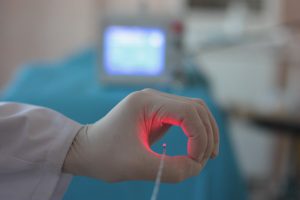Operation: cataract phacoemulsification. Phacoemulsification is a safe treatment for cataracts at various stages.
Is dangerous disease organs of vision, which often leads to complete blindness. the only effective way to cure the pathology is the removal of clouded areas of the lens that have ceased to perform their functions, and the installation of an artificial intraocular lens instead. Previously, surgical therapy consisted of manual tunnel extraction, now cataract phacoemulsification with IOL implantation is increasingly used as a more modern and high-tech technique.
What is cataract phacoemulsification with intraocular lens implantation?
The essence of the operation under consideration is the crushing and removal of dead (clouded) sections of the lens. In place of these non-functional areas, an implant is installed - a soft artificial intraocular lens. It has shape memory and completely takes over the functions of the damaged lens.
How is ultrasonic cataract phacoemulsification with IOL implantation performed?
The sequence of actions during the surgical intervention:
- Local anesthesia.
- Making an incision along the periphery of the cornea up to 2 mm long.
- Insertion of the ultrasonic device tip into the anterior chamber of the eye.
- Simultaneous injection of viscoelastic to protect the internal structures of the eye.
- Formation of an incision on the lens capsule.
- Crushing and turning cloudy areas into an emulsion.
- Suction of damaged tissues of the lens.
- Insertion through an incision on a flexible IOL capsule pre-rolled into a tubule.
- Washing out the viscoelastic from the anterior chamber of the eye with an irrigation solution.
The folded intraocular lens, getting into the cavity of the lens, straightens there on its own, acquiring an ideal shape and securely fixing.
It is worth noting that, due to the microscopic size of the incision on the cornea, suturing is not required after the operation. That's why recovery period takes a minimum time, and in general, surgical intervention is non-traumatic.

Phacoemulsification is the removal of cataracts through microsurgical intervention. During the operation, the nucleus of the lens is destroyed with the help of a specially designed needle - a phaco-tip, which produces high-frequency vibrations. The advantages of this method include:
- low likelihood of complications (2 percent of cases out of a hundred);
- minor main incision (2.2 mm);
- shortened rehabilitation period;
- local anesthesia;
- lack of seams in most cases;
- effectiveness at any stage of cataract development.
The undoubted advantage of phacoemulsification is the absence of pronounced pain at the patient. In some cases, patients complain of a feeling of some tension or slight pressure in the eye.
During the intervention, the crushed lens is removed from the eye, and the surgeon implants an intraocular lens (IOL) in its place. In everyday life, the IOL is also called an artificial lens.
Types and features of IOL
The intraocular lens is made of plastic and consists of an optical part that performs the main purpose of an artificial lens, as well as elements for its attachment to the eye.
There are several types of intraocular lenses, depending on the degree and specificity of visual impairment. The main types of IOLs are:
- Monofocal IOL. This type of lens is considered the simplest and most common. Such an artificial lens allows you to see objects well in the distance, which is typical for presbyopia, or age-related farsightedness. However, a plastic lens, unlike its own lens, does not have the ability to accommodate, so patients additionally have to wear glasses.
Note: the development of American scientists called CRISTALENS IOL is an accommodating monofocal IOL. It changes its position in the eye in a special way, returning the patient's sharpness of vision from any distance. In Russia, a lens of this type has not been tested.
- Multifocal IOL. This type of lens is a unique innovative development. With the help of these implants, the patient has the opportunity to see equally well both near and far, and therefore he will no longer need glasses. However, you should be prepared for the fact that the contrast of vision will decrease, as well as the ability to see in low light conditions.
- Another type of intraocular lenses is presented in the world - aspherical IOL. It is precisely designed to additionally solve the problem of insufficient contrast sensitivity of vision, allowing the patient to return the long-forgotten sensations with a young lens in the eye. In Russia, this type of implant has not yet been tested.
Indications for surgery
Among the indications for the operation of the FEC with IOL implantation, the following should be highlighted:
- age-related cataract, both mature and immature;
- lens;
- clouding of the lens due to diseases of the retina;
- abnormal fusion of the lens and anterior hyaloid membrane in predominantly young patients;
- cataract acquired as a result of injury or burn of the eye.
Contraindications for surgery
Among the contraindications for cataract phacoemulsification with IOL implantation, the following are noted:
- narrow pupil, the diameter of which does not exceed 6 mm;
- brown, or;
- membranous cataract;
- diabetes;
- syndrome of the small anterior chamber of the eye;
- epithelial, or card-like dystrophy of the cornea;
- subluxation of the lens in a patient aged 25 years;
- infectious eye diseases in the acute stage;
- increased intraocular or intracranial pressure;
- ectopia of the lens: its luxation or subluxation.
Important! The presented list of indications and contraindications to is conditional. An exact conclusion about the need and possibility of microsurgical intervention should be made by an ophthalmologist based on the patient's complaints and symptoms of the disease.
Operation progress
In preparation for phacoemulsification, it is necessary to undergo a complete examination by a doctor. The patient undergoes a complete and detailed examination of the organs of vision, as well as a special A-scan, during which the parameters of the lens for the upcoming replacement are determined. Additionally, the ophthalmologist selects eye drops that will be required before the operation.
The operation itself is carried out in several stages:
- Anesthesia. Two types of anesthesia are offered depending on the individual characteristics of the patient's body: instillation of anesthetic drops or injection of a drug to immobilize the extraocular muscles. A combination of both options is allowed.
- Micro incision of the eye. It is performed by the surgeon to access the clouded lens. There is the possibility of small additional incisions if necessary.
- The introduction of viscoelastic. The specified substance protects the structures of the eye from high-frequency vibrations of the needle - the phaco-tip.
Crushing of the lens by ultrasound and its subsequent removal. This procedure is carried out using a special device - phacoemulsifier. - IOL implantation in the capsular bag. An intraocular lens is inserted into the eye through the main incision by means of an injector.
The operation takes no more than an hour. Due to the impermeability of the performed microincision, suturing the cornea after phacoemulsification is not required in most cases, and the patient is discharged home on the same day. A special bandage is applied over the eyes, which can be removed only with the permission of the doctor. Sometimes it may be necessary to wear it at night.
Rehabilitation and restrictions
The recovery period after undergoing microsurgical intervention is on average a month. During this period, the patient should adhere to the following recommendations:
- undergo regular examination by an ophthalmologist;
- wash the organs of vision with a specially prescribed solution;
- take antibiotics, which may also be prescribed after surgery
- avoid swimming in open water to avoid infection of the intervention area;
- limit the concept of gravity;
- avoid vigorous physical activity;
- wear glasses with a UV filter outdoors;
- do not drive until you have received permission from an ophthalmologist.
Cataract phacoemulsification is an innovative method of removing the lens affected by pathology through an ultra-small incision. The method was developed back in the middle of the 20th century by the ophthalmologist C. Kelman. His method of extracting the damaged lens of the eye is the "pearl" of ophthalmic surgery.
Description of the extraction method
The method is based on and is a variation of the previously popular extracapsular lens extraction. The operation - phacoemulsification - refers to the so-called energy interventions performed with the help of energies: laser, ultrasound.
Today, this technique is used everywhere, however, according to indications, other methods of cataract extraction are also used:
- extracapsular extraction (EEC);
- intracapsular extraction (IEC);
- phacoemulsification using ultrasound (PEK);
- laser phacoemulsification (Femto-Cataract);
- Gradually, the methods of EEC and IEC are being replaced by less traumatic ones - ultrasonic and laser phacoemulsification.
Ultrasonic removal method
The essence of the method is that the working part of the phacoemulsifier is introduced into the anterior chamber of the lens of the organ of vision through an incision no larger than 2-3.2 mm in size.

Method of ultrasonic phacoemulsification
An ultrasonic signal of a strictly defined strength is fed into it, which brings the element affected by the cataract into an emulsion state. Then, through a system of hollow tubes with which the tip of the device is equipped, a special solution is supplied, which “washes out” the lens. Through the same devices, the emulsified substance is removed.
The method continues to improve. Today, a sutureless surgical method is used based on self-closing incisions, which made it possible to reduce the time and force of ultrasound exposure in order to avoid injury to the tissues surrounding the lens and shorten the rehabilitation period.
However, this extraction method is contraindicated in certain types of diseases. Ultrasonic extraction should not be used:
- with secondary cataracts;
- with concomitant narrow-angle glaucoma;
- with a hard core (brown);
- at dystrophic change cornea.
Ultrasonic cataract phacoemulsification is not performed in the presence of a very dense, so-called "brown" nucleus, since it is necessary that the energy exposure be at maximum power and for a long time.
In this case, there is a high risk of damage to the tissues of the eye. A variation of the cataract phacoemulsification method is the impact on it with laser energy.
Progress in the field of medical instrumentation has led to the emergence of various variants of this method, which are based on the use of laser energy:
- extreme laser;
- short pulse laser (Er:YAG);
- solid-state laser (Nd:YAG), etc.
The unique domestic method of cataract laser phacoemulsification is based on the use of a solid-state beam with a wavelength of 1.44 microns.
It crushes the nucleus with maximum density, without injuring the tissues of the eye. In addition, laser systems used in ophthalmology allow you to accurately predict the result of the operation.
Operation algorithm
Preparation for the operation takes place in advance. The patient is assigned medications reducing the risk of postoperative complications. The manipulation algorithm is as follows:
- The patient is placed on the operating table, the eye is fixed with a special dilator and is isolated by a shield system.
- Anesthesia is carried out, as a rule, by drip. Sometimes it is combined with sedation of the patient. He is conscious but relaxed.
- The surgeon makes a micro-incision in one of the ways (scleral, corneal, limbal), through which the working part of the ultrasonic or laser device is inserted.
- The eye is filled with a viscous fluid (Viscoelastic) to reduce the traumatic effect of radiation on the tissues of the eye.
- A continuous circular incision (capsulorhexis) of the anterior chamber of the lens is made through a microincision.
- In order to free the lens, hydrodissection is performed - it is “swinging” with a jet of water injected under the capsule.
- The energy of ultrasound destroys the structure of the lens. At the first stage, the most dense part of the lens - its nucleus - is crushed. The lens cortex is then processed, but the surgeon leaves behind a posterior capsule that will support the implant.
- The remains of the lens are brought out with the help of an aspiration system. The procedure for introducing a liquid to “wash out” the emulsified lens and its aspiration occurs simultaneously. At the same time, the posterior part of the capsule is cleaned from lens epithelial cells.
- After the “polishing” and cleaning of the camera is completed, a folded artificial optical lens (IOL) is placed into the capsular bag using an injector, which serves as a replacement for the removed lens.
- The viscoelastic insulating tissue is removed.
- No sutures are applied, the surgical incision is sealed
- The operated eye is closed with a bandage-shield.

How the operation is performed - cataract phacoemulsification with IOL implantation - the video tells in detail. The whole procedure takes no more than 20 minutes.
Types of lenses used
To restore vision, cataract phacoemulsification with IOL implantation is performed using intraocular implants made of different materials:
- polymethylacrylate - light and easy to handle;
- silicone.
Currently, there are more than 300 IOL models, but the development of more advanced implants has not been completed.

Ultraviolet radiation is harmful to the operated eye, so special IOLs are made. The lens of the lens absorbs UV radiation, protecting the retina from damage.
Not all patients require intraocular lenses. With increased sensitivity to the materials from which the IOLs are made, contact and spectacle lenses are used. With the threat of IOL rejection or concomitant ophthalmic pathologies, the patient is given contact lenses.
A very small percentage of operated patients cannot even tolerate contact lenses. They are prescribed glasses, which have many disadvantages compared to the latter. Among them:
- the eye is unable to focus;
- the field of view narrows;
- on the periphery from the central axis of vision, the contours of objects blur.
The cost of cataract phacoemulsification with IOL implantation depends on many factors and varies from 25,000 to 150,000 rubles per eye.
The price depends on the level of the clinic in which the operation is performed, the qualifications of the surgeon, and the chosen implant model. In Ukraine, an operation with implantation of a flexible IOL costs, depending on the lens model, from 6,800 to 36,300 UAH.
Advantages of the extraction method
 The phacoemulsification method has the following advantages over the classical method:
The phacoemulsification method has the following advantages over the classical method:
- carried out on an outpatient basis;
- safe local anesthesia is used;
- does not require suturing, which reduces the risk of postoperative complications;
- carried out in the shortest possible time and does not require long-term rehabilitation;
- allows you to restore vision in full;
- has a minimum of restrictions in the postoperative period.
Improving the installations for the operation and the development of new models of artificial lenses reduce the existing minimal risks.
This method allows you to intervene early stages cataracts without waiting for its maturation, which significantly reduces the risk of postoperative complications and reduces the cost of the manipulation itself.
Postoperative patient care
After the operation, the patient needs to rest for at least a day. It is recommended to eat food only after a few hours, while the food should be light. Some patients may have subjective complaints of pain, burning, itching in the operated eye.
In addition, temporary reactions can occur in the form of dark spots in the field of vision, increased sensitivity to light, hemorrhage, and edema. All these disturbances pass within a few weeks.
After the operation, the patient is prescribed medications in the form of drops, which are used to exclude infection and normalize intraocular pressure. They are recommended to be used for another 1 month after the intervention.
For 2-3 weeks, it is recommended to go outside in sunglasses or a bandage, do not rub your eyes. Unlike other extraction methods, after phacoemulsification, the patient can start working and lead a normal life almost immediately. Periodically, it is necessary to visit a doctor to monitor the condition of the eyes.
Operation video
A cataract is a disease in which the lens of the eye loses its transparency and a person's vision begins to gradually and inevitably fall. As a rule, cataracts occur due to aging of the body, although other causes of the disease are possible.
It is quite simple to restore deteriorated vision, for this it is necessary to remove the clouded lens, and put an artificial intraocular lens in its place. Such an operation is called cataract phacoemulsification.
The safest surgical method removal of cataracts is now recognized as the operation of ultrasonic phacoemulsification (PEK). Performed with simultaneous IOL implantation, phacoemulsification is performed in almost 95% of cases of lens opacification by ophthalmologists around the world with consistently high results.
The operation itself includes three main stages:
- Creating access to the lens through the formation of a micro-incision.
- Crushing the cloudy lens with ultrasound to the state of an emulsion and bringing it out.
- Implantation of an artificial lens (IOL) in place of the removed one.
It is quite obvious that the high effectiveness of such interventions directly depends on the availability of expensive new equipment and the highest skill of surgeons.
Advantages of the phacoemulsification method
Classical methods of operation surgical treatment cataracts, commonly used earlier, were severe enough for the patient and forced him to stay in the hospital for several weeks. During the operation, a long incision was formed through which the clouded lens was removed in its entirety. At the end of the operation, sutures were applied to the eye, after which the patient had to comply with significant restrictions for almost six months.
The latest technology has made the operation much more comfortable and easier for patients. Cataract phacoemulsification is performed on an outpatient basis under local anesthesia and is well tolerated even by the elderly. Here are its main advantages:
- Outpatient surgery. The latest equipment and the advent of soft artificial lenses made it possible to carry out the operation in 15-20 minutes without the need for hospitalization.
- Without pain. The lens cannot hurt, because there are no nerve endings in it. Therefore, during the operation, as a rule, local anesthesia (eye drops) is limited.
- No seams. Thanks to the latest technologies, removal of the lens is performed through a puncture no longer than 2 mm. The operation takes place without suturing, healing proceeds independently and in a short time.
- Short operation time. The duration of the operation rarely exceeds 20 minutes, which is especially valuable for elderly patients.
- Rapid recovery of vision. The ability to see usually returns to the person within a couple of hours after the operation.
- The quality of vision. The implantation of modern intraocular lenses guarantees excellent contrast and color reproduction.
- Maximum effect. Correctly selected intraocular lens and professionalism of the surgeon allow to achieve the highest possible visual acuity.
- Minimum restrictions. With phacoemulsification, unlike outdated methods, the patient has a minimum of restrictions in the postoperative period.
- Fast recovery. After a maximum of 10 days, the patient can return to normal work. Restrictions on loads will last until the end of the month, until the treatment with drops at home ends.

Indications for FEC
Among the main indications for cataract phacoemulsification are usually distinguished:
- Deterioration of visual acuity more than 50% of the original.
- The appearance of a veil and fog before the eyes.
- Halos and highlights from bright light sources.
- Other symptoms of clouding of the lens.
The indication for FEC is any type of cataract and any stage of it. It is optimal to operate an immature cataract, which allows the surgeon to perform the operation as safely as possible with a guarantee of excellent results. This means that the patient no longer needs to waste time and go blind waiting for the cataract to mature, as was the case before. When performing an operation in the early stages of cataract maturity, the risks of surgical and postoperative complications are minimized. The appearance of cataract symptoms is a good reason to immediately contact an ophthalmologist.
FEC operations in the late stages of a mature cataract, as a rule, are accompanied by a high risk of complications. At the same time, the cost of surgical intervention increases significantly.
Operation progress
Cataract phacoemulsification operations in private clinics in Russia are usually performed on an outpatient basis, according to the following scheme:
- The patient arrives at the clinic an hour before the scheduled operation and preoperative preparation begins.
- Solutions of eye drops that dilate the pupil and an anesthetic are instilled.
- The anesthesiologist prepares the patient laid on the operating table for the operation.
- The cloudy lens is removed by the surgeon, after which an artificial lens is implanted without suturing.
- The operation ends.
- The patient goes to the room.
- An hour after the operation, a follow-up examination takes place and the patient returns home with appointments and recommendations.
- The next examination of the doctor takes place the next day after the operation.

The cost of ultrasonic phacoemulsification
Prices for cataract phacoemulsification in private and public clinics differ enough. This creates the illusion that by contacting a municipal health care institution, you can save a lot. But in fact, this is an illusion, because only when faced with the problem closely, patients understand what is worth saving on, and what is better to pay for.
The total cost of a PE operation is made up of many factors that simply cannot be ignored. This is the price segment of the selected clinic, the model of the artificial lens, as well as the experience and “name” of the surgeon. Considering all this, the cost of FEC per eye usually starts from 35 thousand rubles and can reach up to 200 thousand. The cost of the operation in our clinic can be seen below.
Complications of FEC
It is worth mentioning that the success of cataract phacoemulsification directly depends on the skill and experience of the surgeon. In this regard, it is necessary to approach the choice of a specialist and clinic with all seriousness. After all, for novice ophthalmic surgeons, even in quite standard situations, the number of complications is much higher than for their experienced colleagues, and often amounts to 15 percent or more. And this does not take into account complex cases of the disease, such as:
- Weak ligaments of the lens.
- Cataract in diabetes mellitus.
- cataract and glaucoma.
- myopic cataract.
- Other diseases of the body and eyes.
Treatment of complications of cataract phacoemulsification is often long and complicated, and the result in many cases is far from ideal. At the same time, the most frequent complications this operation can become:
- Ultrasound damage to the cornea.
- Damage to the lens ligaments.
- Rupture of the lens capsule and prolapse of the vitreous.
- IOL displacement.
- Other complications.
It must be remembered that any of these complications can become a serious problem for the patient. Therefore, in order for the results of FEC to satisfy and please, it is necessary to take a responsible approach to the choice of a clinic and a surgeon who should be entrusted with eye treatment. This is especially true if you are taking care of elderly relatives, because a well-performed operation is much easier to tolerate, and recovery occurs as quickly as possible.
